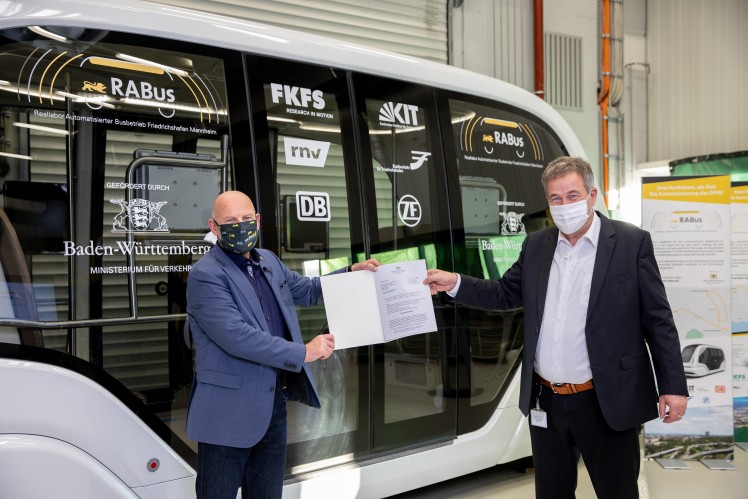Autonomous local public transport introduced in southern Germany
Autonomous local public transport is being introduced in southern Germany through a research project funded with €7 million.
The RABus project is one of the implemented measures of the strategic goals for automated and networked mobility in the southern German federal state of Baden-Wuerttemberg.
Winfried Hermann, Minister of Transport of Baden-Wuerttemberg, handed over the notice of funding in the amount of €7 million to the RABus consortium.
The consortium includes the following organisations and companies:
- Forschungsinstitut für Kraftfahrwesen und Fahrzeugmotoren Stuttgart (FKFS);
- Karlsruher Institute for Technology (KIT);
- Rhein-Neckar-Verkehr;
- Stadtverkehr Friedrichshafen with DB ZugBus Regionalverkehr Alb-Bodensee; and
- ZF Friedrichshafen.
Andreas Brand, mayor of the city of Friedrichshafen, says: “The funding makes us proud, confirms us and drives us decisively further in the direction of future-oriented mobility.

“Since 2018, the city of Friedrichshafen has been investing in the construction and development of a test field for automated driving together with numerous partners from science, medium-sized businesses and industry.
“For good reason: the city is a cradle of mobility history, the headquarters of ZF and the center of a region that develops and enhances mobility at sea, on land and in the air.”
The development, implementation and testing of economical and reliable operation with automated vehicles is of great relevance for the future of local public transport.
Currently, automated vehicles in road-bound public transport are usually only travelling at low speed. This leads to longer travel times and thus to less acceptance and less use.
Changing this is the goal of the research project RABus: Mannheim and Friedrichshafen – supported by the respective traffic associations – act as real laboratories.
In both cities, a public transport system with electrified and automated vehicles is to be established by the end of 2023.
In the Mannheim real-life laboratory, the focus is on automated operation in mixed traffic in a new urban quarter; in the Friedrichshafen real-life laboratory, the focus is on automated countryside operation.
In order to achieve automated and safe driving behavior in the respective environment, the vehicles will operate in regular traffic at acceptable speeds – both in urban and extra-urban areas.
Shuttles from 2getthere, a subsidiary of the ZF Friedrichshafen AG, are used for this purpose.
They offer space for up to 22 people and, with their compact dimensions of 6 x 2.1 x 2.8 meters, can be integrated into the urban traffic flow according to demand and independent of the timetable.
Torsten Gollewski, executive vice president autonomous mobility systems at ZF Friedrichshafen, says: “Our autonomous shuttles are equipped with electric drives, state-of-the-art sensor technology and central computers equipped with artificial intelligence.
“They can also communicate with the infrastructure via connectivity services specifically designed for Level 4 systems. We are pleased that the shuttles will now be in operation in Germany for the first time.
“The approach of the real-life laboratory in Friedrichshafen is a milestone for the urban mobility of the future, as the connection of rural areas to city centers will be very important in the future and will complement the on-demand needs from the outside areas towards the city center; just as we are establishing it in the real-life laboratory in Mannheim.
“The shuttles are equipped with an autonomous travel system, the ‘Virtual Driver’ and other components, a considerable proportion of them were developed in Baden-Wuerttemberg – here in the ‘Land of Tinkerers’; and we are proud to make a contribution to the future of public transport.”
The scientific community is also intensively involved in the project through accompanying research on acceptance, cost-effectiveness and technical solutions.

